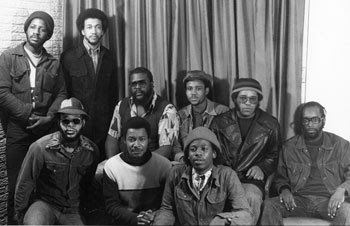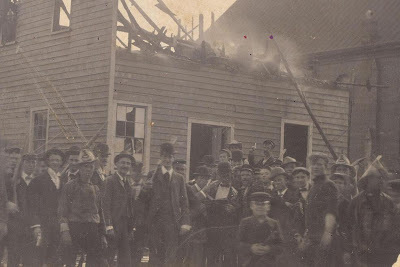The Wilmington 10: A Struggle in History

The Wilmington 10: A Struggle in History by Lamont Lilly | special to NewBlackMan(in Exile)
On Dec. 31, outgoing North Carolina governor, Beverly Perdue, pardoned The Wilmington 10 -- Rev. Benjamin Chavis, Connie Tindall, Marvin Patrick, Wayne Moore, Reginald Epps, Jerry Jacobs, James McKoy, Willie Earl Vereen, William Wright, Jr. and Ann Shepard -- who had sentences ranging from 15 to 34 years following their convictions in 1972. Thankfully, a prolonged national struggle emerged and Perdue was forced to publicly admit that their sentences were “tainted by naked racism” (CNN, Jan. 1). On the very last day of 2012, justice was finally served for the nine Black and one white member of the 10.
In 1978, N.C. governor, Jim Hunt, had reduced the sentences of the 10 but offered no pardon. In 1980, formal charges against The Wilmington 10 were overturned but still on record. It was later reported that prosecutors had manufactured evidence and coerced witnesses. Three of the state’s key witnesses recanted their testimonies in 1980, admitting they had committed perjury. Most of the members of the 10 spent several years in jail. Before Perdue’s pardon, the NC chapter of the NAACP revealed newly discovered documentation that prosecutors intentionally sabotaged the first trial to manipulate jury selection.
Background on the case
In 1971, racial outbursts in the city of Wilmington shocked the world. The political and social undercurrent of racism and bigotry were still festering in the aftermath of the signing of historic Civil Rights bills in 1964 and 1965. Police had murdered a black teenager, while two white security guards had been killed.
The National Guard was called to patrol the city, to protect its downtown and commercial district from a potential race war. All of the key players were in attendance – the Klu Klux Klan and their local support organization, The Rights of White People – while frustrated Black residents including youth towed the progressive side. Anyone who pressed for change and racial solidarity became a threat to social order and the complete reign of white supremacy. Though skin color was the major line, Blacks weren’t the only targets. White allies who were seen as ‘trying to make integration work’ were also targeted by the Klu Klux Klan. White southerner and superintendent of schools, Hayward Bellamy was almost lynched to death in front of his family.
In the newly integrated schools, tensions from the classroom spilled over into the hallways, cafeteria and common areas. Public education was in serious disarray. Black and white residents avoided the streets, while local congregations were in the heat of battle. Wilmington had recently failed at forced integration when Black students were discriminated against in the classroom, from participating in student government, and barred from the debate team and glee club. The city’s false brand of integration had blocked its newly arriving Black students from a 1898—a reign of racist terror
The experiences of The Wilmington 10 actually date back to the 1898 Wilmington Race Riots, to a time of overt racial oppression and forced inequality. These race riots marked a new era of racist reign just two years after the U.S. Supreme Court upheld Jim Crow segregation through Plessy vs Ferguson. This gave the green light to many Black and progressive whites being forcibly evicted from their homes by white supremacists and southern elitists.
 The first order of business for local Klansmen was to break the backs of Wilmington’s black working-class, to disenfranchise their economic stronghold, which by 1895 had just begun to thrive. At this time, Wilmington was the national symbol of Black hope. It was in Wilmington where Blacks owned land and openly participated in local politics. In this small budding city on the outer banks of North Carolina, Blacks were crafts workers, tailors and furniture makers. They were brick-masons, teachers and architects. They were plumbers, plasterers and even owned a newspaper, The Daily Record. Blacks in Wilmington owned 20 of the city’s 22 barbershops and one of the city’s three real estate firms. As then the largest and most prominent city in N.C., it also had a Black-majority population. At the close of the 19th century, Wilmington was one of the few cities in the U.S. were both Black and white people employed each other.
The first order of business for local Klansmen was to break the backs of Wilmington’s black working-class, to disenfranchise their economic stronghold, which by 1895 had just begun to thrive. At this time, Wilmington was the national symbol of Black hope. It was in Wilmington where Blacks owned land and openly participated in local politics. In this small budding city on the outer banks of North Carolina, Blacks were crafts workers, tailors and furniture makers. They were brick-masons, teachers and architects. They were plumbers, plasterers and even owned a newspaper, The Daily Record. Blacks in Wilmington owned 20 of the city’s 22 barbershops and one of the city’s three real estate firms. As then the largest and most prominent city in N.C., it also had a Black-majority population. At the close of the 19th century, Wilmington was one of the few cities in the U.S. were both Black and white people employed each other. The second order of business was the white working class who had allied with local Blacks. The Klu Klux Klan was looking to intimidate anyone who supported an interracial new America. In 1898, armed white militia terrorized such social unity and achievements. Hate mongers burned down businesses and the headquarters of the Black-owned newspaper. Well-organized mobs targeted successful Black citizens and local leaders with direct violence, gunfire and permanent banishment. The offices of Black politicians and city officials were raided and taken over. Wilmington’s 1898 Race Riot was a critical turning point in the history of the South, a crucial blow to the pursuit of freedom and equality for all.
Needless to say, The Wilmington 10 and the racial outburst of 1971 was merely a reflection of deep-rooted oppression from decades earlier – political and social conditions that restricted progress in Wilmington, forcing Black youth to take a stand in response to being fed up with the city’s 70-year status quo.
The Wilmington 10 are a testament to the spirit of true resistance, the epitome of people power, and the potential of interracial solidarity. As high school youth, The Wilmington 10 lived what we must embody today – the will of struggle in the face of hate. Their recent pardon was a big step forward in the struggle for justice, but the people must never forget. As the next wave of revolutionaries, we must borrow from their spirit. We must take their batons and continue to march on.
***
Lamont Lilly is a contributing editor with the Triangle Free Press, Human Rights Delegate with Witness for Peace and organizer with Workers World Socialist Party. He resides in Durham, NC. Follow him on Twitter @LamontLilly.
Published on January 09, 2013 04:02
No comments have been added yet.
Mark Anthony Neal's Blog
- Mark Anthony Neal's profile
- 30 followers
Mark Anthony Neal isn't a Goodreads Author
(yet),
but they
do have a blog,
so here are some recent posts imported from
their feed.



